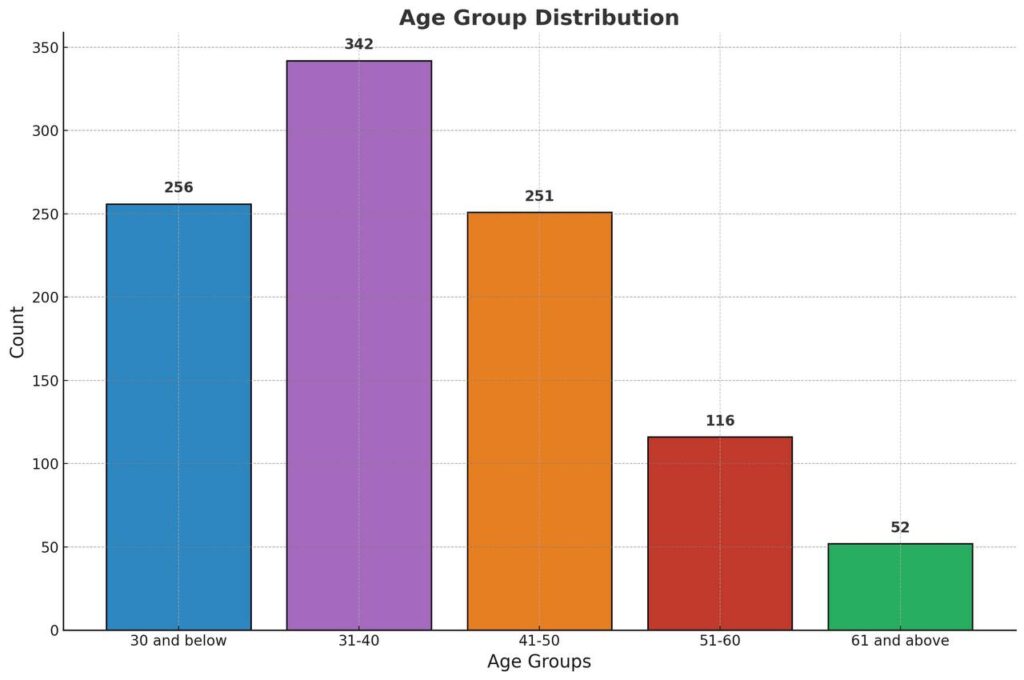The following analysis is based on the data provided by the Uyghur Transitional Justice Database in the 2020 report, “The Persecution of Uyghurs in East Turkistan”.
Basic composition of our dataset on internees is as follows:
243 or 15.4% are female, 1,337 or 84.6% are male, 13 unclear (1,593 in total)
| Profession | Number | Ratio |
|---|---|---|
| Actor/Actress | 18 | 3.52% |
| Architect | 1 | 0.20% |
| Astronomer | 1 | 0.20% |
| Writer | 13 | 2.54% |
| Butcher | 1 | 0.20% |
| Chef/Cook | 3 | 0.59% |
| Designer | 5 | 0.98% |
| Doctor | 19 | 3.71% |
| Engineer | 11 | 2.15% |
| Factory worker | 1 | 0.20% |
| Farmer | 19 | 3.71% |
| Hairdresser | 3 | 0.59% |
| Journalist | 8 | 1.56% |
| Lawyer | 6 | 1.17% |
| Lecturer | 6 | 1.17% |
| Librarian | 2 | 0.39% |
| Nurse | 3 | 0.59% |
| Pharmacist | 1 | 0.20% |
| Photographer | 2 | 0.39% |
| Police Officer | 6 | 1.17% |
| Realtor | 1 | 0.20% |
| Scientist | 1 | 0.20% |
| Secretary | 1 | 0.20% |
| Tailor | 3 | 0.59% |
| Taxi-driver | 2 | 0.39% |
| Teacher | 68 | 13.28% |
| Bookkeeper | 5 | 0.98% |
| Businessperson | 52 | 10.16% |
| Civil Servant | 20 | 3.91% |
| Craftsman | 1 | 0.20% |
| Editor | 44 | 8.59 |
| Newly Graduated | 1 | 0.20% |
| In the Judiciary | 5 | 0.98% |
| Linguist | 3 | 0.59% |
| Head of a Department (under a provincial government) | 2 | 0.39% |
| Poet | 14 | 2.73% |
| Professor | 18 | 3.52% |
| Clergyman | 22 | 4.30% |
| Researcher | 12 | 2.34% |
| Sportsman | 2 | 0.39% |
| Student | 99 | 19.34% |
| Village Communist Cadre | 2 | 0.39% |
| Webmaster | 5 | 0.98% |
| Total | 512 | 100.00% |
| Educational Background | Number |
|---|---|
| Bachelor’s Degree | 298 |
| Junior College for Professional Training (⼤专) | 8 |
| High School | 76 |
| Master’s Degree | 7 |
| Middle School | 98 |
| No education | 10 |
| PhD | 20 |
| Primary School | 54 |
| Professor | 16 |
| Total | 587 |
As illustrated in the above tables, 162 have either primary/middle school education or no education at all, while over 300 have a university degree. However, it may not be a representative sample since the educational background is known for only 1/3 of the entire dataset.
The average age for females is 44, for males 38.3, and for the whole dataset is 39, though we only managed to procure the age info of 1,017 of the total 1,593 people.

As listed above 586 or 57.6% of the total dataset are aged 35 or above, which indicates that these internees are not in an age group that would normally receive job training in East Turkistan.
Regional distribution of the interned is as follows:
| City | Numbers Registered |
|---|---|
| Aqsu | 39 |
| Atush | 32 |
| Bortala | 1 |
| Ghulja | 80 |
| Khotan | 31 |
| Korla | 26 |
| Qaramay | 9 |
| Kashgar | 136 |
| Qumul | 3 |
| Sanji | 2 |
| Turpan | 28 |
| Ürümchi | 193 |
| n/a | 1013 |
| Grand Total | 1593 |
In our collected data, only 1/3 of the internees’ place of internment was known, and given that the sampling of this dataset is not random, it may not represent the overall geographical internment pattern across East Turkistan. Ürümchi might have a higher representation simply because more data was collected concerning Ürümchi internees, which could be attributed to better communication, or maybe other confounding factors.
Of the 1,503 that were detained/interned in 2016 or later (or for whom no date of arrest is known), only 69 are shown as released, although this is a variable where information is problematic, because detainees/internees might be released without the knowledge of their relatives outside of China. Even if that were the case, the known rate of release is still very low (i.e. 4.6%).
The religious status of the detainees/internees is only known for about 1/3 of them. Of the 658 for whom it is registered, 54 are shown as not practicing or not religious, 532 as practicing, and 71 as religious scholars. However, the exact meaning of “practicing” is not well defined, and most Uyghurs might be categorized as such. Nevertheless, the share of religious scholars is quite high.
Of 545 for which Chinese language skills are shown, 131 are shown to have no or only basic skills, with about 1/3 or 168 being fluent. Clearly, the camps hold many people who either have a good education, or have good or exceptionally good Chinese language skills, or both.
With respect to the health condition, only 379 people have such data point registered, and most (299) of whom were healthy. This is likely to a degree dependent on age, given that not few in detention are elderly.
Overall, this dataset broadly confirms our existing knowledge that the camps do not primarily or only hold young people with little education or no jobs, but also substantial shares of people who are some or all of the below:
- Of middle or older age
- Well-educated
- Holding good jobs
- Speaking Chinese well
Contrary to the propaganda images, the vast majority of detainees/internees are men, often middle-aged. This is consistent with other data indicating that the Chinese regime’s internment campaign has primarily targeted heads of households.
Source: “The persecution of Uyghurs in East Turkistan” Authors: Erkin Kâinat; Adrian Zenz; Adiljan Abdurihim
Link: https://www.utjd.org/register/wp-content/uploads/2020/09/the_persecution_of_uyghurs_hard_copy.pdf



